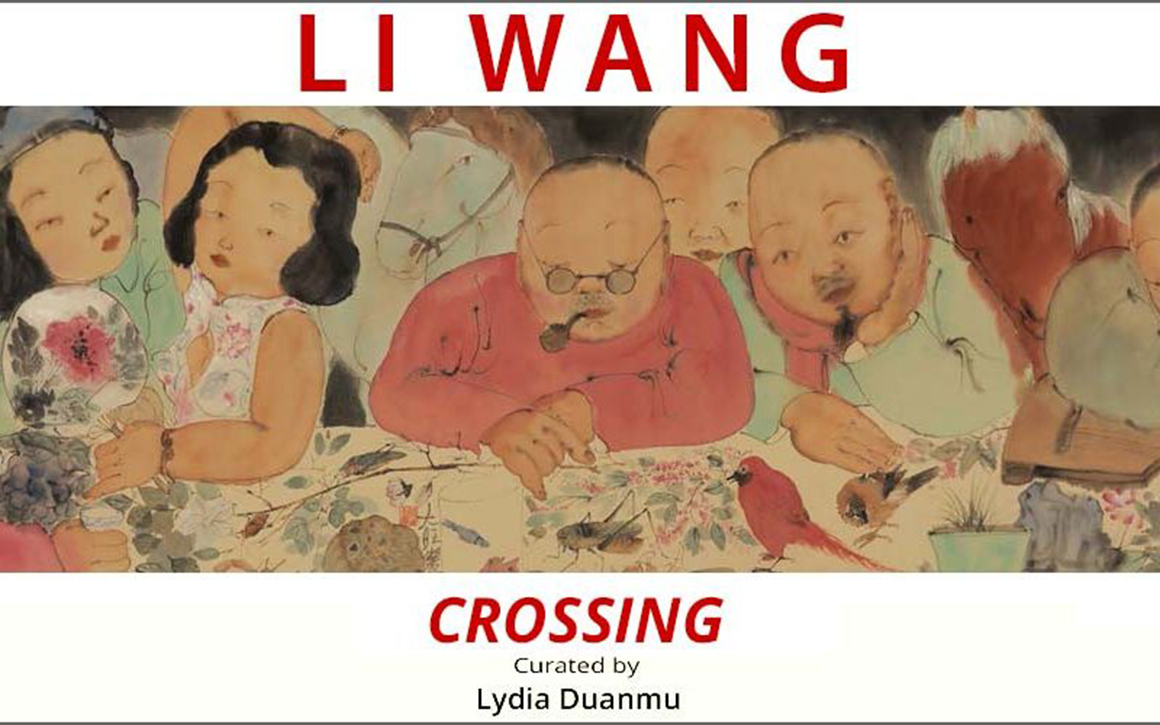Li Wang – “Crossing”,October 12th, – October 30th, 2017.
Art talk: ” The Family Structure of the Chinese”, Saturday, October 14, 2017, 4-6 pm.
RSVP: Required
Hours – Wednesday to Saturdays, 1-6 pm or by appointment.
We recently published an interview on the revival of Chinese brush painting featuring Beijing artist/art dealer Lydia Duanmu. We’re proud to share the follow-up, a Q&A which she conducted with artist and compatriot Wang Li as he opens up about the importance of nature, nostalgia, and harmony in his paintings.
How would you describe your work as a contemporary artist who works mainly with ink painting and as a professor with considerable tenure?
I live in an era of tumultuous changes in Chinese, ideological, material, and spiritual culture. It seems like people’s understandings of life values have been ever-changing. However, as a professor of arts and an artist myself, my experience and perception of beauty is constant and uninterrupted. This is a characteristic amongst intellectuals of my generation – we strive to maintain our curiosity and innocence. I always keep a relaxed and humorous attitude to life.
Certain figures, like colorful horses, men doing handstands, and flying fish, appear in your work repeatedly. What are their significances?
When we were young, all our toys were simple and came from nature. I remember when I was in primary school, my parents gifted me a little bird. The bird was not only like a family member to me, but it was also my best friend. Every morning I would talk to it and feed it, and the first thing I did after school was to greet it. Every time I called its name, it would fly over and land on my head or shoulder. We built a really deep bond and had a truly unique connection. But then one day my uncle was visiting and he accidentally sat on my bird. And just like that, the bird passed away. I mourned for a long time and the pain and sorrow of a child who had lost his beloved friend found its way into my paintings. The emotions fueled my creativity.
I think a lot of people from our generation share this kind of nostalgia for their past – the sentimental memories from their childhood. The memories of the toys, aroma of food we grew up eating, and the familiar streets which we could navigate with our eyes closed. No matter how much money we are willing to spend, these memories are resting/buried in the distant graveyards of our childhood. Although these clips of our childhood are in the past, they still exist deep down in our psyche; They frequent our dreams and their visits bring back the warm familiarities of our childhood.
I am very fond of nature. My work is a direct reflection of my attitude towards life. The man doing the hand stand in the paintings could be myself as I ruminate about life and the world from another perspective. Societal constructs have set rules for everyone the moment they are born. So I like to try and imagine and look at the systematic and law filled world from another perspective.
In my eyes, those lively horses, flying fish, and chirping birds are symbols of virtue. This morality of humankind and nature living in harmony is the central theme of Chinese philosophy, and this sentiment is not limited within borders but common across cultures.
What emotions did you aim to express through your painting work on RED TIE?
In primary school, a lot of Chinese honored and yearned wearing the red tie, the sign of the Young Pioneers of China. The Red tie left deep imprints in my childhood memories; I remember that when I was in primary school, so that we could join the Young Pioneers as early as possible, to get the teacher’s appreciation my classmates competed to do a variety of things that were considered good and virtuous. For example, they would return lost items or money to the teacher, help the underachieving students with homework, pick up litter and horse manure, organize Marxist-Leninist and Mao Zedong Thought study groups, and so on.
Although these might seem kind of absurd and ridiculous today, we were full heartedly committed and tried to be on our best behavior at all times. The pride in our hearts when we wore the red tie “dyed by the blood of martyrs” is indescribable. Now that I have entered the wrong side of forty, the societal perception of the red tie has shifted completely but the red tie still lives vividly in my memory. In this work, the figure dressed in the Mao suit, wearing small rounded glasses, with a pipe in mouth, and with a blank expression on his face is an incarnation of my current self. In front of his chest elegantly floats the bright red tie. Present society has undergone drastic changes; whether it’d be economic or social formation and people’s values have seen profound changes. Though we are no longer troubled by basic survival needs, economic development has assigned us new social and environmental problems. We ponder about our association with these societal shifts and their influences. Nowadays, these doubts and materialistic desires of people have created such a void in my life, that only the red scarf with its flicker of childhood memories keeps me grounded.

